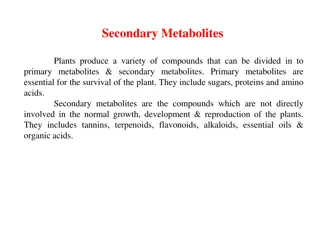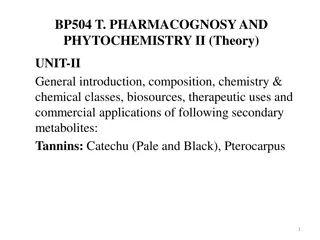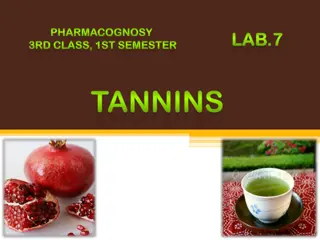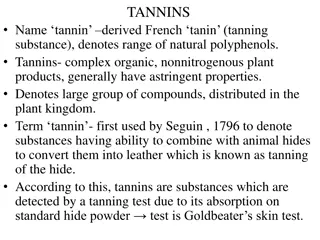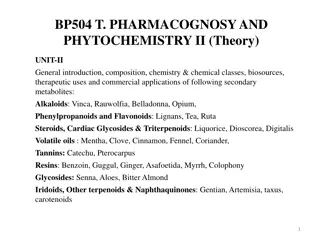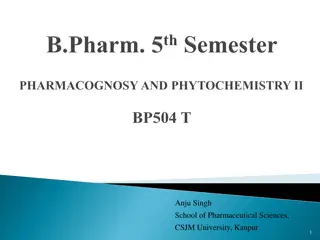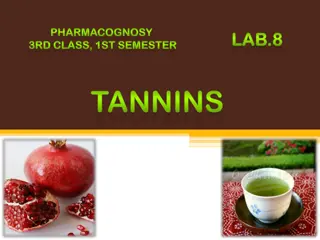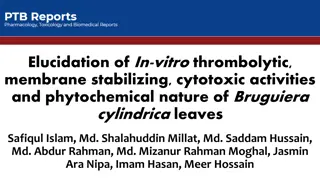Understanding Tannins: Properties, Classification, and Medicinal Uses
Tannins are secondary metabolite products with astringent properties, high molecular weight, and various solubility and taste characteristics. They can be classified into true tannins and pseudo-tannins based on the Goldbeater skin test, as well as hydrolysable and condensed tannins based on chemica
6 views • 13 slides
Understanding Plant Metabolites: Primary vs. Secondary & Their Biological Functions
Primary metabolites are crucial for plant survival, including sugars and amino acids, while secondary metabolites, like tannins, terpenoids, and flavonoids, play diverse roles such as protection from pathogens, pigmentation, and health benefits. Tannins offer antiviral and antibacterial effects, ter
0 views • 7 slides
Overview of Tannins: Composition, Chemistry, and Reactions
Tannins are complex organic substances found in various plant sources known for their astringent properties. They have therapeutic uses in medicines and commercial applications in industries like leather. Tannins form colloidal solutions, exhibit specific chemical reactions, and are classified into
2 views • 25 slides
Understanding Tannins: Properties, Uses, and Structures in Pharmacognosy
Tannins, complex phenolic glycosides found in plants, have various properties such as water solubility and ability to precipitate proteins. They are important for their astringency and therapeutic uses in tanning, treating burns, and as antioxidants. The interaction of tannins with macromolecules is
3 views • 18 slides
Understanding the Classification of Tannins in Plants
Tannins, derived from French "tanin," are natural polyphenols found in plants with astringent properties. They can be classified into true tannins and pseudotannins based on the Goldbeater's skin test. Hydrolysable tannins can be further categorized into gallotannins and ellagitannins, while condens
4 views • 8 slides
Overview of Indole Alkaloids in Pharmacognosy and Phytochemistry II
Indole alkaloids are a significant group of naturally occurring compounds with diverse chemical structures and physiological actions. This unit delves into the general introduction, composition, chemistry, biosources, therapeutic uses, and commercial applications of various secondary metabolites, in
0 views • 17 slides
Exploring Secondary Metabolites in Ruta Graveolens for Therapeutic Applications
Delve into the world of secondary metabolites found in Ruta graveolens, commonly known as Rue or Garden Rue. Discover its rich composition of alkaloids, phenylpropanoids, flavonoids, steroids, cardiac glycosides, triterpenoids, volatile oils, tannins, resins, glycosides, iridoids, and other terpenoi
0 views • 13 slides
Understanding Tannins in Pharmacognosy: Properties, Structure, and Uses
Tannins are phenolic compounds found in plants, known for their complex nature and diverse properties. They are soluble in various solvents, play a role in tanning leather, and have medicinal uses such as treating burns and acting as antioxidants. The interaction between tannins and macromolecules i
0 views • 18 slides
Study on Phytochemical Nature and Biological Activities of Bruguiera cylindrica Leaves
Investigation of phytochemical constituents and biological properties such as thrombolytic, membrane stabilizing, and cytotoxic activities of Bruguiera cylindrica leaves. Phytochemical screening revealed the presence of carbohydrates, glycosides, phenols, tannins, proteins, gums, and mucilages. The
0 views • 16 slides
Exploring the King George Wine Society and Palate Education
Immerse yourself in the world of the King George Wine Society, founded by Bill NSV Jacques Recht, a renowned winemaker. Discover the intricate elements that form the structure of wine, including acidity, alcohol, body, sweetness, and tannins. Join engaging events to educate your palate on body, flav
0 views • 24 slides

